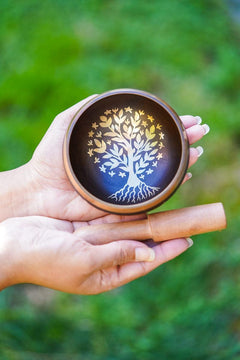What is Thangka?
A thangka (also called tangka, thanka, tanka, or Tibetan scroll painting) is a classical and stylised form of Nepalese and Tibetan painting, consisting of a painted picture panel surrounded by a textile mantle that is supported by scroll sticks and overlain with a silk cover. The mantle is typically constructed from a rich material, usually silk brocade, and the painting is generally executed in oils on treated cotton duck, although some notable exceptions occur, including pictures created from pigments ground from semi-precious stones, appliqué and silk or cotton embroidery. Thangkas typically depict important Buddhist motifs, the Wheel of Life, images of the Buddha, other Buddhist deities and mandalas being the most common. Thangka paintings are usually very intricate and detailed, with images inter-woven in a stylised geometric series of overlapping grids, taking many weeks or even months to complete. As stated by Wikipedia:

Thangkas overflow with symbolism and allusion. Because the art is explicitly religious, all symbols and allusions must be in accordance with strict guidelines laid out in Buddhist scripture. The artist must be properly trained and have sufficient religious understanding, knowledge, and background to create an accurate and appropriate thangka.
Thangkas fulfil several important functions for the practitioners of Tibetan Buddhism. The images are used to teach students and monks about the aspects of Buddha, describe important historical events and illustrate myths associated with important deities. Devotional images act as a focus during rituals and ceremonies and are often used as mediums through which prayers are offered and particular requests made. Most importantly, thangka art is a valuable meditation tool and offers a manifestation of the divine that is both visually and mentally stimulating.
From the 14th century onwards, Chinese painting had a significant influence on Tibetan art and by the 18th century, Tibetan painting echoed and incorporated many Chinese elements of detail and design. However the thangka itself is traditionally held to be a Nepalese invention introduced to Tibet by Princess Bhrikuti of Nepal who married Sron Tsan Gampo, the ruler of Tibet, around 620-632 CE. Because they could be easily rolled and transported, thangkas became increasingly popular among the nomadic monks of medieval Tibet who travelled extensively between rural communities and regional monasteries to provide religious instruction. They are still used today for teaching and are a familiar sight in both Nepal and Tibet, becoming increasingly common in the West along with the spread of eastern spirituality.
Visual expression

On a deeper level thangka paintings can be seen as a visual expression of the highest state of consciousness, which is the ultimate goal of the Buddhist spiritual path. This is why a thangka is sometimes called a ‘roadmap to enlightenment’, as it shows you the way to this fully awakened state of enlightenment.
Ceremonial use

Up until today some Tibetan monasteries possess huge scrolls -usually appliqué thangkas– that are unrolled on certain holidays (such as for Losar, Tibetan New Year) for public viewing and ceremony, as you see here.




